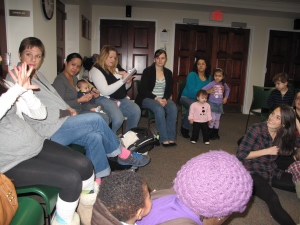Review of December’s Holiday Meeting (importance of babywearing)
“Put that baby down, you’re spoiling her.” “He’s never going to learn to walk if you keep carrying him.” “Just let her cry, it’s good for her lungs.” We’ve all heard it, or something like it. The well-intended criticism from family and friends can often make you want to snap and say things you might regret. Be prepared this holiday season when it comes to babywearing. Instead of getting frustrated, be ready to teach them about why babywearing is great for your baby in so many ways!
babywearing. Instead of getting frustrated, be ready to teach them about why babywearing is great for your baby in so many ways!
The meeting was started, as usual, with some quick introductions. Then Alexis did an amazing job summing up the key points on the importance of babywearing in about 15 minutes. Although an entire book could easily be written on the subject, I will try to sum up the key points as efficiently as she did:
Altricial, Precocial, and Secondary Altricial Young
There are three different “types” of young, each born with different primal instincts directly after birth.
- Altricial young are born relatively immobile, unable to cry out in need, and needs to be nourished. Most small birds and rabbits fall into this category as they must remain in a nest waiting for a parent to return with nourishment.
- Precocial young refer to species that are relatively mature and mobile shortly after birth such as deer that walk almost immediately and chickens which leave the nest shortly after birth.
- Human babies fall into a completely different category all together called Secondary Altricial, also sometimes called “parent clinger” or “carried young.” As Secondary Altricial creatures, humans are born very needy, crying for closeness, eating frequently, and needing touch. However, they are also born with a plethora of reflexes that help with long term development. Some of them, such as the Palmer grasp (holding on), Moro reflex (startle when dropped), rooting reflex (to find nipple for breastfeeding) among others are all catered to by wearing the baby.
Developing Skeletal System
- Humans are also born with a soft, underdeveloped skeletal system made of mostly cartilage. The ankles are turned in, the shins are curved, and the pelvis is tilted forward and doesn’t fuse until about 9 months. The most significant difference in infants is the curvature of the spine. Unlike adults who have 3 curves, infants are born with 1 C-shaped curve. Babywearing caters perfectly to this natural newborn form and even helps with the formation of the first curve in the neck. In fact, the purpose of the often dreaded tummy-time is to develop and strengthen the first neck curve. If you wear your child often tummy time is completely unnecessary until baby is happily ready for it!
Bodies are Built for Babywearing
- Digestive health – Wearing your baby keeps baby close to you and is amazingly effective in regulating bodily functions. Tummy to tummy time massages the stomach to help promote digestive health.
- Breathing regulation – Infants often need mom to regulate breathing. The sound of your breath and beat of your heart is a natural soundtrack to keep your baby calm and breathing regularly.
- Body temperature regulation – Spending time skin to skin can help regulate body temperature. If baby has a fever you can remove clothing and wear her skin to skin and your body temperature will drop to bring down the temp of your feverish baby. If a young infant needs to be warmed your body temperature will rise as needed to warm him. Babies are born with most of their fat on their back and in their legs. Their fronts have significantly less fat which means their backs are naturally insulated and their fronts can be warmed naturally and easily by your body!
- Balance and movement – The proprio-vestibulary system, developing largely in the first 3 months, is critical for baby’s sense of balance, movement, and self-perception. Due to the nature of Babywearing, children are forced to use their core muscles as you walk around. This is perfect for the development of balance, core muscles, and self-awareness. Children who are worn often walk and talk earlier than children who are not.
- Brain development – Research has shown that babies are somewhat wired by what they learn in the early weeks and months. The environment a child is born into will affect their brain chemistry in the future. A child born into a secure and loving world will develop with oxytocin to promote calmness. Conversely, a child born into an insecure or overwhelming world will develop with cortisol to promote stress. This does not mean it would be impossible to have a secure child that began with a rough start. It simply means that starting a baby in a secure world will more likely lead to security later on.
- Benefits of touch – Touch is a natural and inherent need of all humans. Frequent physical contact with your baby has been shown to decrease postpartum depression and increase breastfeeding success!
Thank you Alexis, for such a thorough lesson in the benefits of babywearing!
The meeting was finished off with the usual collection of people using the lending library and help from others to learn new babywearing skills and perfect old ones. We also had our holiday party with lots of delicious food. Special thanks to Takisha Miller of Cake Seduction for her delicious crumb cake!
Special note to all! If you are considering a new wrap consider buying from Pax Baby and mentioning you are from Babywearers of Northern NJ. We are working towards a new ring sling for the lending library and every purchase helps!

